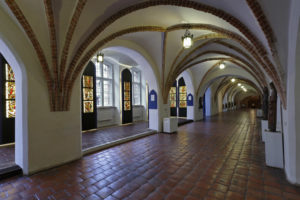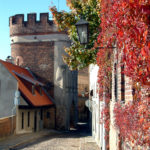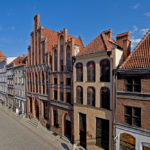 The Old Town Hall (Ratusz Staromiejski). A substantial Gothic building, built towards the end of the 14th century on a quadrangle outline, it has been the town’s commercial and administrative centre since the medieval times. The burghers used to gather by the window of the Court Room – on the northern, least sunny side of the Town Hall – to listen to the verdicts given inside. The bakers’ stalls were located on the ground floor of the East Wing, the cloth stalls in the West Wing. The first floor of the Town Hall housed the Town Council chamber, Royal Apartments, and, taking up the whole of the East Wing, the Great Hall in which the most important ceremonial events were held. The tower, built as early as the 13th century, held the town archive and treasury, while the vast cellars were used to store beer and wine. The Polish Sejm (Diet) was held several times in the Town Hall, and in 1501 king Jan Olbracht died there. The Town Hall was rebuilt and an extra floor was added in the Renaissance period, and hundred years later, it burned down during the Swedish siege of Toruń. The tented roof section of the tower was never rebuilt and reminds of the fire to this day, but the Town Hall itself was rebuilt in the 18th century and continued as a seat of the town authorities. Since 1958, it has been functioning as a regional museum (Muzeum Okręgowe).
The Old Town Hall (Ratusz Staromiejski). A substantial Gothic building, built towards the end of the 14th century on a quadrangle outline, it has been the town’s commercial and administrative centre since the medieval times. The burghers used to gather by the window of the Court Room – on the northern, least sunny side of the Town Hall – to listen to the verdicts given inside. The bakers’ stalls were located on the ground floor of the East Wing, the cloth stalls in the West Wing. The first floor of the Town Hall housed the Town Council chamber, Royal Apartments, and, taking up the whole of the East Wing, the Great Hall in which the most important ceremonial events were held. The tower, built as early as the 13th century, held the town archive and treasury, while the vast cellars were used to store beer and wine. The Polish Sejm (Diet) was held several times in the Town Hall, and in 1501 king Jan Olbracht died there. The Town Hall was rebuilt and an extra floor was added in the Renaissance period, and hundred years later, it burned down during the Swedish siege of Toruń. The tented roof section of the tower was never rebuilt and reminds of the fire to this day, but the Town Hall itself was rebuilt in the 18th century and continued as a seat of the town authorities. Since 1958, it has been functioning as a regional museum (Muzeum Okręgowe).
The current Cathedral of St. John the Baptist and St. John the Evangelist was, until 1992, a parish church. The Gothic church was built over the period of 200 years, on the location of the oldest Toruń church from the 13th century. The oldest section of the current building is the early-14th century chancel, the newest includes the tower, originally designed to be higher, from the first half of the 15th century. In 1500, the then-largest bell in Poland, ‘Tuba Dei’, was hanged in the tower. Nicolaus Copernicus was baptised in this church, and it is also here that the heart of king Jan Olbracht who died in Toruń in 1501, is buried. The interior of the cathedral houses many preserved monuments of Gothic art: fragments of original stained glass, many paintings from the 14th century, several original altars, sculptures and tombstones. The 16th to 18th century remains include Baroque altars in the side chapels, the organ and some Copernicus related objects: his first monument and a Renaissance period epitaph.
The Church of the Assumption of the Blessed Virgin, adjacent to the north-eastern corner of the market square, was built in the second half of the 14th century by the Franciscan monks who arrived in Toruń as early as 1236. Due to the severity of the Order’s rule, the church has neither a tower nor sophisticated architectural decorations. The construction, innovative for its time, and the weight of the roof, resulted in the northern wall of the church leaning from the vertical. Inside, there are many valuable medieval artefacts, including wall paintings from the end of the 14th century, oak choir stalls and a sculpture of entombed Christ. The church became the most important Protestant place of worship in Toruń between the 16th and 18th centuries, and it this period it gained a Renaissance organ, a pulpit and numerous tombstones and epitaphs, including the exceptional Baroque mausoleum of Anna Wazówna, a sister of king Zygmunt III Waza (Vasa) from 1636. Other fittings, including a richly decorated Baroque altar and an impressive rainbow arch dates to the 18th and 19th centuries.
The Church of the Holy Ghost, a previous Lutheran place of worship, built between 1754 and 1756 to replace several buildings burnt down during the Swedish siege of 1703. It was built as a result of religious riots of 1724, after which the town’s Protestant community lost its most important temple, the current Blessed Virgin church. Eventually, the Protestants were allowed to build a prayer hall which was not to resemble a typical church. For that reason, the Baroque building had lacked a tower, which was only added in the last years of the 19th century. The Rococo fittings suffered in the dangerous fire of 1989, which destroyed the historical organ, now reconstructed. Since 1945, the church has been in the care of the Jesuit order.
Find out more on www.visittorun.com





